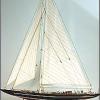-
Posts
298 -
Joined
-
Last visited
Reputation Activity
-
 The Sailor reacted to henryjames in J Class yacht Endeavour 1934 by henryjames - FINISHED - Amati - Scale 1:80 - First Ship build
The Sailor reacted to henryjames in J Class yacht Endeavour 1934 by henryjames - FINISHED - Amati - Scale 1:80 - First Ship build
Update number 2,
boom done,
mast done,
The kit comes with a rather handy ship mount which is pretty useful
onto the hull,
central hull line support glued ensuring its super straight (apologies the name escapes me!)
horizontal spacers now all glued in,
the curvature of the hull is quite extreem in some places, so planking looks like it will be quite a task!
next step is to sort the bow and stern blocks, and sand them like crazy!
I have to paint the mast and boom with 'matt white enamel' paint,
does anyone have any recomendations on where to get this from?
In addition anyone any clue what colour to paint the top half of teh hull
(I'm jumpng the gun here but thought I'd get a jump start!
also the provided sails are printed on, does anyone have any thoughts on these
(is it better to buy new blank linen/cloth and make new ones?)
-
 The Sailor reacted to Keith_W in Bounty Launch by KeithW - FINISHED - Model Shipways - SMALL - kitbashed
The Sailor reacted to Keith_W in Bounty Launch by KeithW - FINISHED - Model Shipways - SMALL - kitbashed
I'm back from my trip, so I have continued some work with this boat. Over the weekend, I completed the standing rigging.
I have seized shrouds many times in the past, but I have never been satisfied with the results. This is the theory:
So how do you do that in miniature scale on a ship model? The answer is to use crocodile clips, like this:
If you can't see what's happening, I have created a series of diagrams that show how the seizing is accomplished. The text and pictures are self-explanatory.
This is the result:
I also added an eye bolt for the mainmast stay. Mackay's plans indicate that this was present, but did not indicate where it was attached - so I took a guess.
The boat as of tonight:
Next I should tackle the spars and sails, but I am thinking of buying a cheap sewing machine to help me make the sails. The sails are therefore on hold until I do a bit of research and learn how to sew on spare cloth. Neither can I attempt making the oars, because I want to reserve that for when my new lathe arrives. I suppose i'll just make the toolbox and a few other little accessories while I wait.
It also appears that I have run out of rigging thread. Let's hope that my local hobby shop stocks the same thread used by Model Shipways.
-
 The Sailor reacted to Mirabell61 in Heinrich Kayser 1898 by Nils Langemann - FINISHED - scale 1:96 - as she appeared in 1922
The Sailor reacted to Mirabell61 in Heinrich Kayser 1898 by Nils Langemann - FINISHED - scale 1:96 - as she appeared in 1922
Build log part 5
for making the stand Posts I use brass candle holders (found on flee-markets)
the anchorchain port reinforcements are fitted
begin... rivited structure to deckhouses and hatch rims
further Fitting out
midship deckhouses, on deck inbetween the coal bunker hatchcovers
forecastle compartments
so far well under way...
workdecks ready for priming, painting
the figures are scale 1:100
the portside depth indications are in Roman figures
Build log part 6 to follow....
-
 The Sailor reacted to Mirabell61 in Heinrich Kayser 1898 by Nils Langemann - FINISHED - scale 1:96 - as she appeared in 1922
The Sailor reacted to Mirabell61 in Heinrich Kayser 1898 by Nils Langemann - FINISHED - scale 1:96 - as she appeared in 1922
Build log part 4
characteristic for These old steamships are the large vents, necessary more than ever when going through hot,tropical zones of calm sea...
Here is to give my Version of the vent Hood making..., and the main masts, and crows nest
sizes and types of vents
an Arrangement of inlet and outlet vents
prefit check with the decks
application of primer after soldering and cleaning the brass surfaces
was quite a bunch of individual parts
inner Hood surfaces have their own color
as well as the outside surfaces
Forward and aft mast
do not throw away your old dome-nuts, they serve for exellent venthoods
especially those where the dome Shell is made and brased on of thin pressed sheet
Build log part 5 to follow.....
-
 The Sailor reacted to Mirabell61 in Heinrich Kayser 1898 by Nils Langemann - FINISHED - scale 1:96 - as she appeared in 1922
The Sailor reacted to Mirabell61 in Heinrich Kayser 1898 by Nils Langemann - FINISHED - scale 1:96 - as she appeared in 1922
Building log part 3
brought on White primer coating and Sub waterline red
the last Picture where the hull is still fixed to the baseplate. The upper hull portions shall be plated and painted when the decks have been permanently mounted
hull seperated from baseplate, all went well, no Twist, no destortions
extreme lightweight hull, prop- and ruddershaft already mounted, superstructure for deck Support can be seen
riged structure in forecastle area
decks made from 1,5 mm thick 4-layer Aeroplywood
the Forward maindeck, 3 hatches, and the quite Long poopdeck, 2 hatches,(working decks) are going to be metal plated. These decks were of steel plating due to rough cargo handlingand overcoming heavy seas. The cardboard template behind hatch #4 Shows the riviting pattern for deck plating
hatch # 1 behind the forecastle bulkhead
bow section before finalizing the decks and the final plating
raw workdecks mounted, midship deckhouses started, hull painting done and forecastle bulleyes mounted. It`s now slowly looking like a ship should be...
Build log part 4 to follow.....
-
 The Sailor reacted to Mirabell61 in Heinrich Kayser 1898 by Nils Langemann - FINISHED - scale 1:96 - as she appeared in 1922
The Sailor reacted to Mirabell61 in Heinrich Kayser 1898 by Nils Langemann - FINISHED - scale 1:96 - as she appeared in 1922
Build log part 2
planking completed, rudder and sternpost reinforcement mounted, minimized Polyesterfiller where necassary, and poopquarter knee-whale attached
impressions of rudder making components
the five blade prop is only an interim solution, a four blade historic prop with blades bolted-on the central hub is to follow later
here first time experience Begins with metal plating for hull
The hull wooden surface is sanded smooth and fixed with quick dying transperant liquid filler, which drys off quickly leaving a real smooth and shiny surface on which the self-adhesive Aluminium foil sticks like hell. No Problem with roll-embossing the foil plates from the rear plate side, because the rivit immitations are roolled-in before the protection foil on the plate rearside is removed, giving free the glue film.
Workstation for making the plates
leave a gap between first and second plating line, the third plating line is set by overlapping the edges of first and second line
Note : vertical rivit Joints have 4 rows of rivits, horizontal Joints have 2 rivit rows
plating nearly done, the whole hull is still mounted to the shipyard baseplate
Mounted into the keel are two reinforced M5 female threads for the later to be mounted stand-bolts
the upper hull portions have not been plated yet
soldered, full functional mounted rudder before plating, shaft going through to poop deck
here the upside down 135 cm Long hull is nearly ready for seperating from the baseplate, it is very stiff, riged and of lightweight
-
 The Sailor got a reaction from Mirabell61 in Heinrich Kayser 1898 by Nils Langemann - FINISHED - scale 1:96 - as she appeared in 1922
The Sailor got a reaction from Mirabell61 in Heinrich Kayser 1898 by Nils Langemann - FINISHED - scale 1:96 - as she appeared in 1922
Thanks for the build log Nils. I'm really surprised about the sails on the plan...
-
 The Sailor reacted to Mirabell61 in Heinrich Kayser 1898 by Nils Langemann - FINISHED - scale 1:96 - as she appeared in 1922
The Sailor reacted to Mirabell61 in Heinrich Kayser 1898 by Nils Langemann - FINISHED - scale 1:96 - as she appeared in 1922
Steamship Heinrich Kayser
Introduction to this build log, by Nils Langemann
The steamship Heinrich Kayser was launched in 1898 baptized to its birthname „Elbing“ and was one of the typical new fast merchant vessels built for the D.A.D.G. (Deutsch Australische Dampfschiffahrts Gesellschaft) shipping company at the FSG shipyard in Flensburg, northern Germany. It served the trade route Europe via Cape of Good Hope or via Suez Canal and the red sea and across the Indian Ocean to several Australian Ports together with her sister ships on regulary basis for many years.
After WW1 and in compliance with the Treaty of Versailles demands the Elbing went under command and management of a british shipping controller, from which the “Elbing” was bought back again by the Hamburg based Kayser & Sohn shipping Company in 1921, which renamed the vessel to “Heinrich Kayser”. In 1922 my grandfather was appointed as the master in command on its last fatal voyage from England to the US eastcoast, down to Florida and back touching Norfolk Virginia as last port and thereafter went down with all aboard her in a heavy full gale and with broken rudderchain and broken hatchcovers. The last SOS radio signals came from position of the New England Seamount Chain, some 500 miles off the US eastcoast where the Atlantic is 5000m deep. No survivers, not a trace was ever found. This type of ship was a mere cargo steamer of 5600 tons, which may have been able to accommodate 2-3 passengers, midships. The Heinrich Kayser was capable of cruising at max. of 12 knots with her twin-boiler arrangement in tandem setup, and having appr. 20 firemen (stokers and heaters), working in shifts to keep the boilers at pressure accordingly.
I built this model, which is already completed to date, after a shipyard overview plan in honor to my grandfather and all its 43 souls crew and three passengers.
It is only a couple of weeks ago that per incidence, and 91 years after that foundering, on a raised web forum thread I was able to take up contact with an american lady, who`s great grandmother as well as her great aunt have been on board the Heinrich Kayser at that time and lost their lives as passengers way back in 1922
The build log shall comprise probably 21 individual parts due to limit of pics per post, and shall document all building sequences in pictures. Comments, questions, etc. shall be welcome and answered along with the build log as it grows.
The model took me appr. 1800 manhours to build over 2 years including the search for a plan, new modeling techniques like metal- plating /”riveting”, soldering, glass-case making, all trials, etc.
The fully completed model can be viewed in my album (steamship Heinrich Kayser) under topic : Gallery of completed scratch built models
Have fun and enjoy whilst studying this oldtimer steamer of 1898 in its buildup
Nils
Here it Begins.....
Build log part1
this is one of the ship under its birthname "Elbing"
this is one of the very last Pictures of the Heinrich Kayser
overview plan frontsection
overview plan aftsection
stringers and single-layer planking in pine
planking under way, propshaft built in
Frame plan, self drawn, not included in overview plan
planking nearly completed
Part 2 to follow....
-
 The Sailor reacted to Jeronimo in LE BONHOMME RICHARD by Jeronimo - FINISHED
The Sailor reacted to Jeronimo in LE BONHOMME RICHARD by Jeronimo - FINISHED
Hi friends,
cannons for assembly on the Gun-Deck prepared.
Karl
T e i l 4 1
-
 The Sailor got a reaction from Timothy Wood in J-class yacht Endeavour 1934 by The Sailor - Amati - 1:35
The Sailor got a reaction from Timothy Wood in J-class yacht Endeavour 1934 by The Sailor - Amati - 1:35
Haha, I‘m following the instructions.
The photo shows the reason:
The stripes along the rail edges are part of the deck with one difference: They are blue like the hull above the waterline. That means planking the deck first and then sanding the complete deck to get everything to the same level. After this part is done I can paint the hull. The reverse order would spoil the coat of paint.
-
 The Sailor got a reaction from hexnut in J-class yacht Endeavour 1934 by The Sailor - Amati - 1:35
The Sailor got a reaction from hexnut in J-class yacht Endeavour 1934 by The Sailor - Amati - 1:35
Thank you very much for your big interest, Alfons, Kerry and Floyd.
You are right Floyd, the instructions are very limited. I started with the bulb area covering and then down from the deck line. I did the same with the second planking.
Well, painting the hull. In fact Endeavour have a steel hull but one option of the kit is leaving the bottom covered with the mahogany planking. The photo shows how big this area is.
I didn't measure the waterline exactly, but I think it's a little to low on this photo.
-
 The Sailor reacted to Alfons in J-class yacht Endeavour 1934 by The Sailor - Amati - 1:35
The Sailor reacted to Alfons in J-class yacht Endeavour 1934 by The Sailor - Amati - 1:35
Richard.
Is the deck planked with mahogany as well? Will it be painted or left natural?
Anyways, I am very keen to follow your planking progress The size of your Endeavour certainly allows for a deatailed and beautiful deck planking.
Keep up the good work.
/Alfons
-
 The Sailor got a reaction from hamilton in J-class yacht Endeavour 1934 by The Sailor - Amati - 1:35
The Sailor got a reaction from hamilton in J-class yacht Endeavour 1934 by The Sailor - Amati - 1:35
Haha, I‘m following the instructions.
The photo shows the reason:
The stripes along the rail edges are part of the deck with one difference: They are blue like the hull above the waterline. That means planking the deck first and then sanding the complete deck to get everything to the same level. After this part is done I can paint the hull. The reverse order would spoil the coat of paint.
-
 The Sailor got a reaction from Q A's Revenge in J-class yacht Endeavour 1934 by The Sailor - Amati - 1:35
The Sailor got a reaction from Q A's Revenge in J-class yacht Endeavour 1934 by The Sailor - Amati - 1:35
Haha, I‘m following the instructions.
The photo shows the reason:
The stripes along the rail edges are part of the deck with one difference: They are blue like the hull above the waterline. That means planking the deck first and then sanding the complete deck to get everything to the same level. After this part is done I can paint the hull. The reverse order would spoil the coat of paint.
-
 The Sailor reacted to fnkershner in J-class yacht Endeavour 1934 by The Sailor - Amati - 1:35
The Sailor reacted to fnkershner in J-class yacht Endeavour 1934 by The Sailor - Amati - 1:35
Very Nice! so your Planking is done. Thanks for the info. She actually look like a very easy build. Have you decided what Blue paint you are going to use?
-
 The Sailor reacted to hamilton in J-class yacht Endeavour 1934 by The Sailor - Amati - 1:35
The Sailor reacted to hamilton in J-class yacht Endeavour 1934 by The Sailor - Amati - 1:35
Excellent work Richard - will you be marking the waterline with a white stripe? She's really shaping up.
hamilton
-
 The Sailor reacted to Kerry in J-class yacht Endeavour 1934 by The Sailor - Amati - 1:35
The Sailor reacted to Kerry in J-class yacht Endeavour 1934 by The Sailor - Amati - 1:35
Wow great job - painting a hull like this would cover some impressive work, could you make that decision a bit later ?
Kerry
-
 The Sailor reacted to fnkershner in J-class yacht Endeavour 1934 by The Sailor - Amati - 1:35
The Sailor reacted to fnkershner in J-class yacht Endeavour 1934 by The Sailor - Amati - 1:35
Nicely Done! I think when I get there I will just plank over the slot.
-
 The Sailor reacted to Alfons in J-class yacht Endeavour 1934 by The Sailor - Amati - 1:35
The Sailor reacted to Alfons in J-class yacht Endeavour 1934 by The Sailor - Amati - 1:35
Good work Richard! How about skipping that paint and go for 7-10 layers of vanish on the whole hull instead..
/Alfons
-
 The Sailor got a reaction from Julie Mo in J-class yacht Endeavour 1934 by The Sailor - Amati - 1:35
The Sailor got a reaction from Julie Mo in J-class yacht Endeavour 1934 by The Sailor - Amati - 1:35
Thank you very much for all your nice comments and hitting the „Like“ Button.
Hi henryjames, I‘m looking forward to seeing your build log.
Hi Row, first of all you are a lucky man been aboard of Endeavour. Well, it‘s an odd hull form and - believe me - not everything looks perfect. But overall I‘m happy with the result and in doubt I can paint the whole hull.
Hi klimi, I‘m building her as the Endeavour of 1934.
Erik, the part straight above the rudder was indeed tricky to plank. As you can see on the photo, this part is moulded using wood filler.
Fortunately the vaneer stripes are very easy to bend.
Finally the last two photos:
The planked stern...
and the evidence...
...that the slot is still open!
-
 The Sailor got a reaction from Timothy Wood in J-class yacht Endeavour 1934 by The Sailor - Amati - 1:35
The Sailor got a reaction from Timothy Wood in J-class yacht Endeavour 1934 by The Sailor - Amati - 1:35
Thank you very much for your big interest, Alfons, Kerry and Floyd.
You are right Floyd, the instructions are very limited. I started with the bulb area covering and then down from the deck line. I did the same with the second planking.
Well, painting the hull. In fact Endeavour have a steel hull but one option of the kit is leaving the bottom covered with the mahogany planking. The photo shows how big this area is.
I didn't measure the waterline exactly, but I think it's a little to low on this photo.
-
 The Sailor got a reaction from jdbradford in J-class yacht Endeavour 1934 by The Sailor - Amati - 1:35
The Sailor got a reaction from jdbradford in J-class yacht Endeavour 1934 by The Sailor - Amati - 1:35
Thank you very much for all your nice comments and hitting the „Like“ Button.
Hi henryjames, I‘m looking forward to seeing your build log.
Hi Row, first of all you are a lucky man been aboard of Endeavour. Well, it‘s an odd hull form and - believe me - not everything looks perfect. But overall I‘m happy with the result and in doubt I can paint the whole hull.
Hi klimi, I‘m building her as the Endeavour of 1934.
Erik, the part straight above the rudder was indeed tricky to plank. As you can see on the photo, this part is moulded using wood filler.
Fortunately the vaneer stripes are very easy to bend.
Finally the last two photos:
The planked stern...
and the evidence...
...that the slot is still open!
-
 The Sailor got a reaction from yvesvidal in J-class yacht Endeavour 1934 by The Sailor - Amati - 1:35
The Sailor got a reaction from yvesvidal in J-class yacht Endeavour 1934 by The Sailor - Amati - 1:35
Thank you very much for all your nice comments and hitting the „Like“ Button.
Hi henryjames, I‘m looking forward to seeing your build log.
Hi Row, first of all you are a lucky man been aboard of Endeavour. Well, it‘s an odd hull form and - believe me - not everything looks perfect. But overall I‘m happy with the result and in doubt I can paint the whole hull.
Hi klimi, I‘m building her as the Endeavour of 1934.
Erik, the part straight above the rudder was indeed tricky to plank. As you can see on the photo, this part is moulded using wood filler.
Fortunately the vaneer stripes are very easy to bend.
Finally the last two photos:
The planked stern...
and the evidence...
...that the slot is still open!
-
 The Sailor got a reaction from fnkershner in J-class yacht Endeavour 1934 by The Sailor - Amati - 1:35
The Sailor got a reaction from fnkershner in J-class yacht Endeavour 1934 by The Sailor - Amati - 1:35
Thank you very much for your big interest, Alfons, Kerry and Floyd.
You are right Floyd, the instructions are very limited. I started with the bulb area covering and then down from the deck line. I did the same with the second planking.
Well, painting the hull. In fact Endeavour have a steel hull but one option of the kit is leaving the bottom covered with the mahogany planking. The photo shows how big this area is.
I didn't measure the waterline exactly, but I think it's a little to low on this photo.
-
 The Sailor got a reaction from VonHoldinghausen in Mercury by The Sailor - Amati/Victory Models - 1:64 - Russian 20 gun brig
The Sailor got a reaction from VonHoldinghausen in Mercury by The Sailor - Amati/Victory Models - 1:64 - Russian 20 gun brig
Thank you very much Jeff, Nils and Mark.
Well, I think I was just lucky with the first planking. Believe me, the kit supplied walnut stripes for the second planking are of very good quality. Besides the bulwark area needs a stronger planking.
And here are the first pictures:
Look at this:
This is a very remarkable stern design for a ship of the 19th century.












